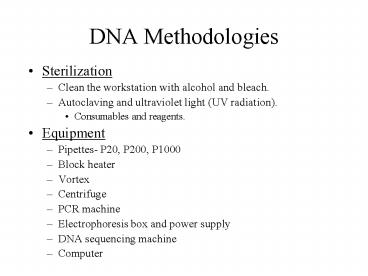DNA Methodologies PowerPoint PPT Presentation
1 / 17
Title: DNA Methodologies
1
DNA Methodologies
- Sterilization
- Clean the workstation with alcohol and bleach.
- Autoclaving and ultraviolet light (UV radiation).
- Consumables and reagents.
- Equipment
- Pipettes- P20, P200, P1000
- Block heater
- Vortex
- Centrifuge
- PCR machine
- Electrophoresis box and power supply
- DNA sequencing machine
- Computer
2
DNA Protocol
- DNA Extraction
- FTA Card
- Chelex
- Spin columns
- Organic- simple and differential.
- DNA Quantitation
- Direct, non-blot
- Direct, slot-blot
- Real Time PCR
- PCR Amplification
- Polymerase Chain Reaction
- DNA Sequencing or Typing
- Analysis and Interpretation
3
Human Cell
- How do we get the nuclear and mitochondrial DNA
- out of the cell?
4
DNA Extraction Protocols 1
- FTA Card
- Pipette aliquot on card.
- WBCs lyse on paper and DNA is trapped.
- Use hole punch to remove paper for DNA analysis.
- Wash.
- Analysis.
5
FTA Protocol
6
(No Transcript)
7
DNA Extraction Protocols 2
- Chelex
- Incubate blood sample in 5 Chelex at 56C for 30
min. - Boil for 8 min.
- Centrifuge to remove inhibitors and cellular
debris.
8
DNA Extraction Protocols 3
- Column Extraction
- Lyse cells and digest proteins.
- Physical, heat, detergent
- Proteinase K
- Bind DNA to silica membrane by centrifugation.
- Wash with 70 ethanol by centrifugation.
- Elute DNA with TAE (Tris-Acetate - EDTA) or water
by centrifugation.
9
(No Transcript)
10
(No Transcript)
11
(No Transcript)
12
DNA Extraction Protocols 4
- Organic Extraction
- Lyse cells and digest proteins.
- Physical, heat, detergent
- Proteinase K
- Organic extraction.
- Phenol-chloroform
- Centrifuge to remove supernatant.
- Precipitate DNA.
- Ethanol or isopropanol
- Centrifugation to pellet DNA.
- Elute DNA with TAE or water.
13
Differential Extraction
- Technique used to separate sperm cells from
non-sperm cells (epithelial cells). - Vaginal swabs
- 1. Epithelial cells are lysed with a mild
extraction buffer containing Sodium Dodecyl
Sulfate (SDS). - 2. Centrifugation to pellet sperm cells, DNA from
epithelial cells is in the supernatant. - 3. Lyse sperm cells using Dithiothreitol (DTT).
14
DNA Quantitation
- DNA Quantitation
- Direct, non-blot
- Direct, slot-blot
- Real Time PCR
- Why quantitate?
- U.S. FBI Standards require it!
- 1ng-2.5ng yields consistent typing results.
- 1 cell 6.1pg (164 cells needed for analysis)
- Too much DNA leads to artifacts and too much
signal. - Too little DNA leads to allelic dropout.
15
DNA Quantitation 1
- Direct, non-blot
- AluQuant (Promega Corp.)
- Human-specific probe that binds to Alu insertions
(highly repetitious DNA). - Luciferin-luciferase reaction and a luminometer
to detect the amount of light. - Emission is compared against standards.
- Yield Gel
- Standards of known concentration are compared
against a sample.
16
DNA Quantitation 2
- Direct, slot-blot
- QuantiBlot (Applied Biosystems)
- Human-specific probe (D17Z1) binds to DNA.
- Chemiluminescence is used to determine the DNA
concentration against a set of standards.
17
DNA Quantitation 3
- Real Time PCR
- Quantifiler (Applied Biosystems)
- Human genes are amplified.
- Gene number doubles after each cycle.
- Each cycle yields more fluorescence.
- Fluorescence is recorded and compared against
standards to determine DNA concentration.

